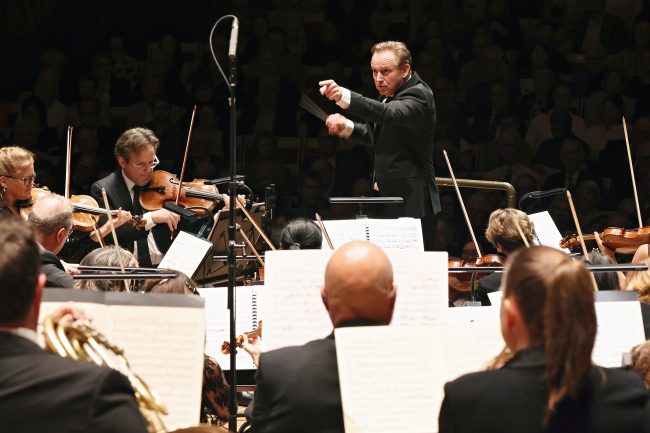Friday 24 November 2023
Review by Paul Neeson (Arts Wednesday)

“The pinnacle of western classical music” is how AWO Chief Conductor and Artistic Director, Alexander Briger describes Mahler’s 9th Symphony. It is a monumental work of 1.5 hours requiring 98 musicians to perform.
But the Australian World Orchestra is no ordinary band. Formed only in 2011, once a year Maestro Briger brings Australian orchestral musicians who perform with the crème de la crème of international orchestras (think London Symphony Orchestra, Concertgebouw Orchestra and Vienna Philharmonic Orchestra just to name a few) back home for a very limited number of concerts. Also in the mix are the who’s who of Australia based orchestral musicians. This year they performed one concert in Melbourne and last night’s concert at the Sydney Opera House.

Mahler’s 9th is no ordinary symphony either. It is much more than 90 minutes of lush, complex, highly emotional symphonic writing. It is a philosophical treatise on the mortality of man, concluding, like Plato, “that death should be viewed as the achievement of life”.
To argue this philosophy, Mahler employs some of the most complex chromatic harmony in the western canon, allowing him to set up layer upon layer of conflicting emotions, each striving to find some kind of resolution – just like life itself. Also Mahler’s brilliant use of orchestration is unequalled. In the first movement the use of the low register of the harp (Alice Giles) is the harbinger of impending trouble, countered by the solo flute (Andrew Nicholson), the song of innocence. The orchestra was very disciplined as different motifs interrupted the narrative, representing conflicting emotions, and then blended seamlessly into the next chapter of the journey. Within 2 bars of the opening notes the pitch was perfect and stayed that way throughout, and within 10 bars the balance between instruments under the baton of Briger was flawless. No mean feat for a recently assembled orchestra of that size. The tension built and built throughout the first movement with the penultimate dominant chord accumulating more suspensions than a Hitchcock thriller. How will this ever resolve we begin to wonder? On a single note played by an unaccompanied piccolo (Linda Stuckey) is how. Those of us not intimately familiar with the score didn’t see that coming.
Austro-Bohemian born Mahler in his symphonies can rarely resist a triple time dance on the sunny banks of an alpine river, and the 2nd movement was such a dance. But never far from the bucolic action were some buffoons preparing to cause trouble. And as the gluhwein flowed the musical conflict escalated. And at the end of the mayhem, the solo piccolo (the highest instrument of the orchestra, an angel perhaps) was there again to return peace to the world.

The third movement swung back and forth between the sadness of death and the positive realisation that life continues for those left behind. But it was the final movement that brought tears to our eyes as the life force slowly ebbed from the dying figure at the centre of the musical narrative, “the disintegration of life” as Adam Fischer said. This was mirrored by the lighting which slowly faded to just the music stand lights and finally just a single overhead spot on the conductor as he held the final silence for an eternity. The standing ovation at the conclusion was well deserved. Our emotions were well and truly drained, but the sense of satisfaction and peace was palpable nonetheless.
This is a symphony that has inspired thousands and thousands of words to be written, and mine are just a few more spoken in awe of this great work. And this heroic interpretation of it.
In his recent interview, Alexander Briger said that the Australian World Orchestra was in a sense created to play this work, its raison d’être, and in his capable hands the AWO reached a level of maturity rarely achieved by such a young orchestra. I can’t wait for the reveal of the 2024 program.
You can listen to a recent interview with Chief Conductor, Alexander Briger here.